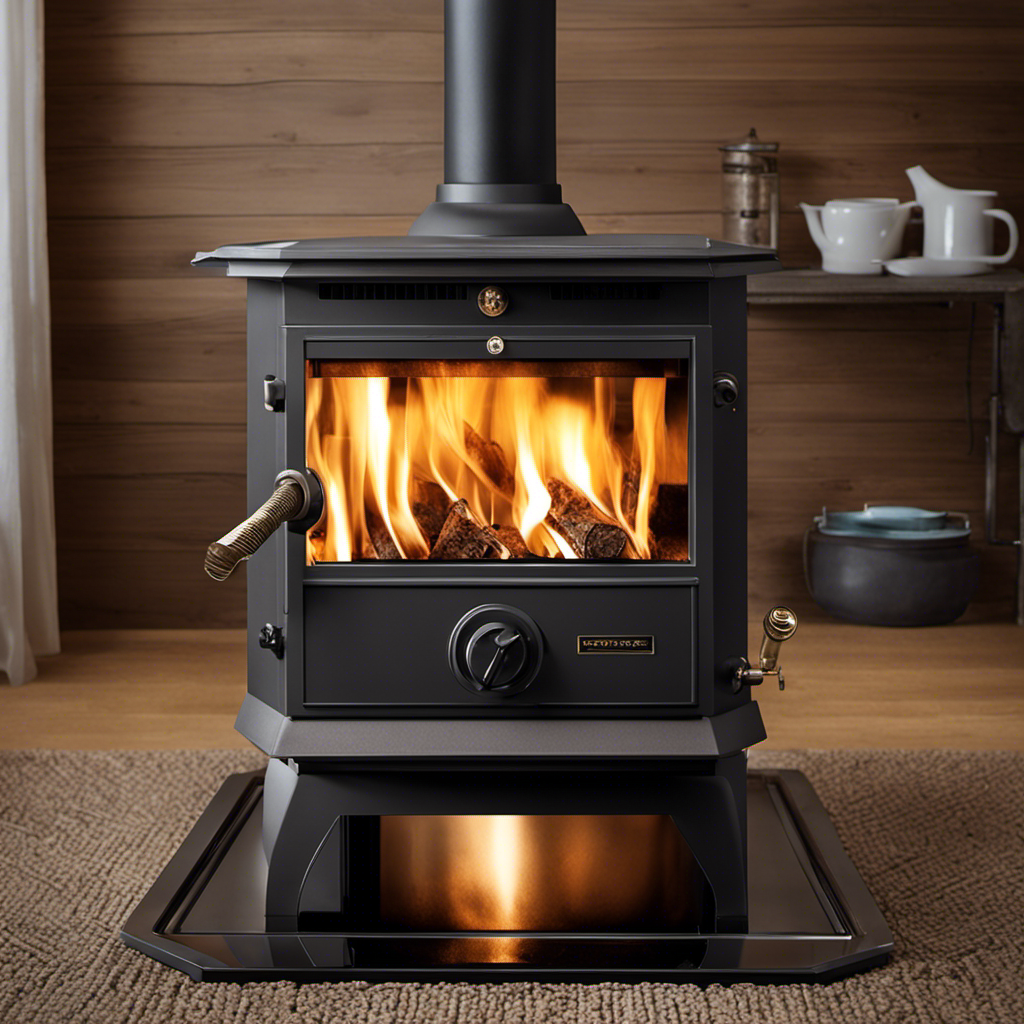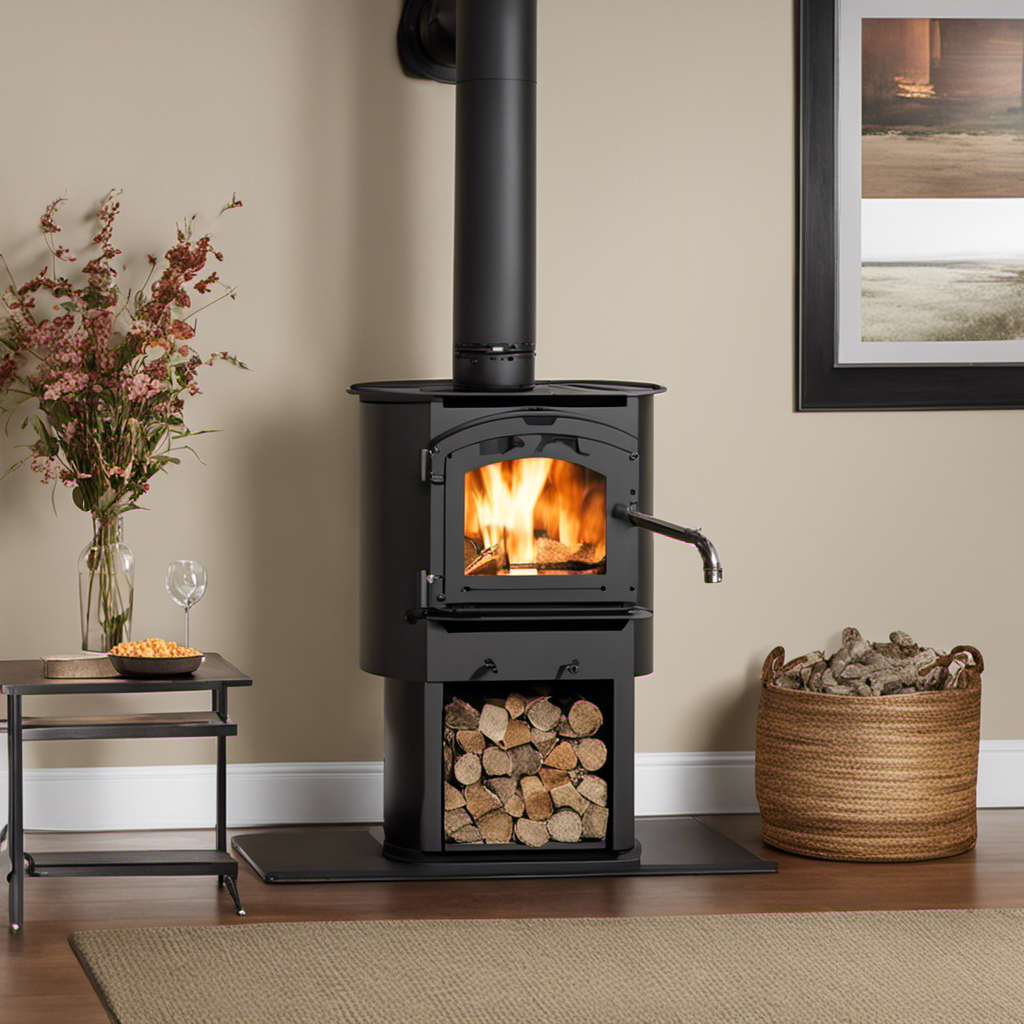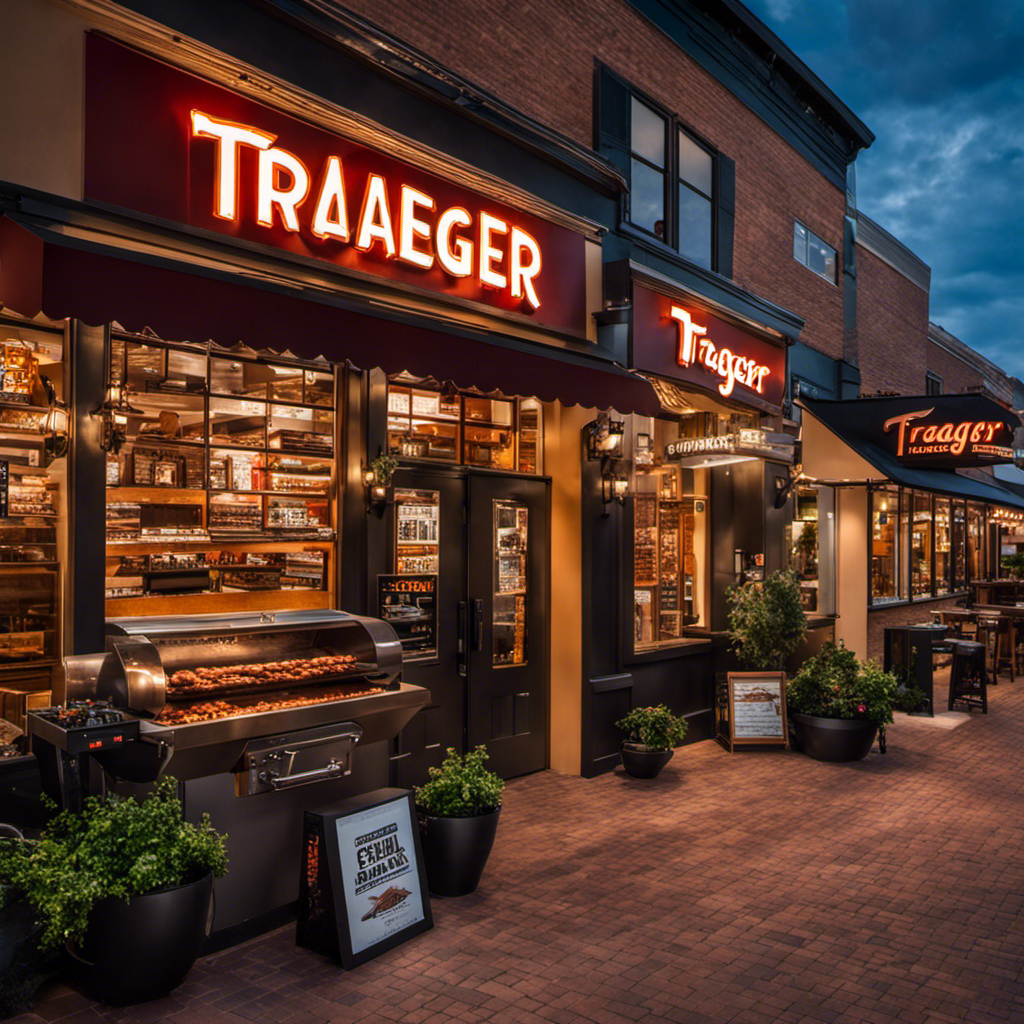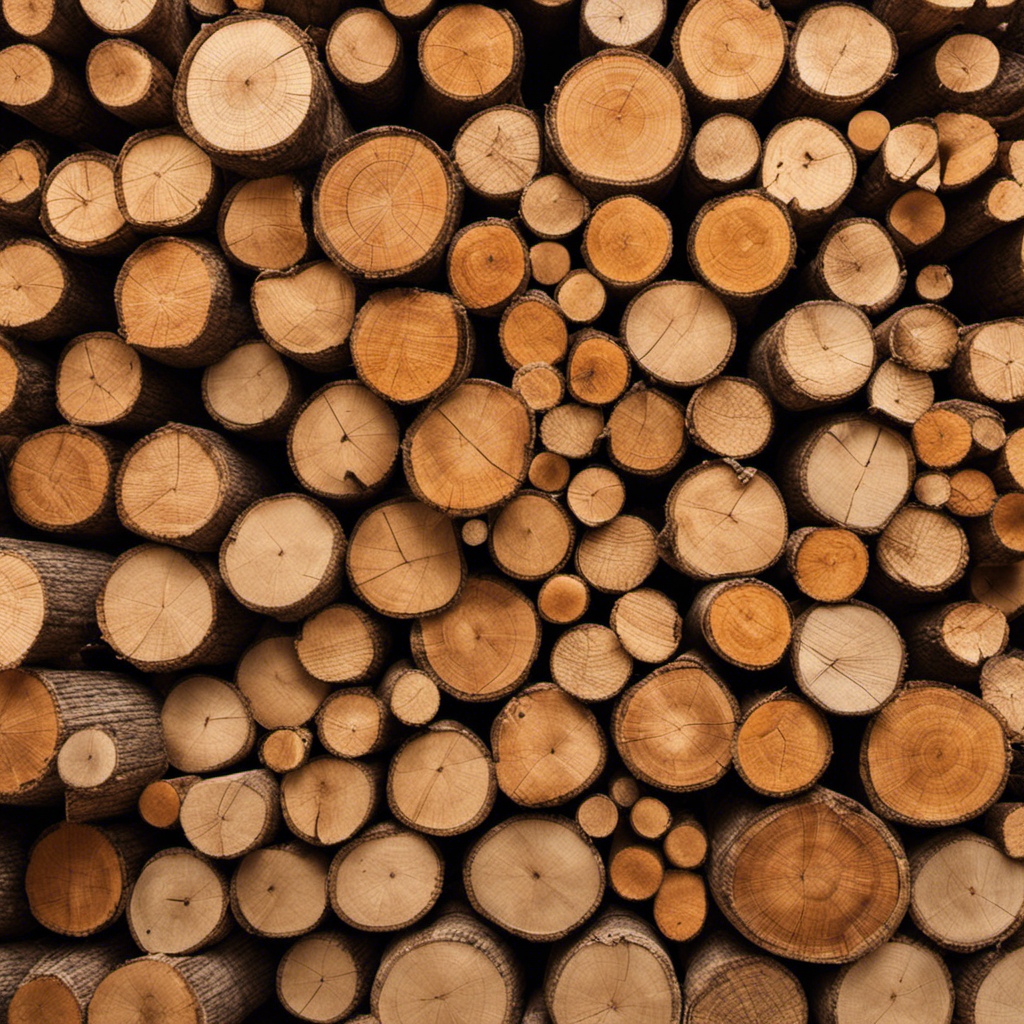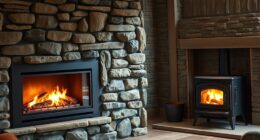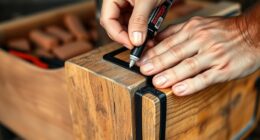Were you aware that operating a wood pellet stove has the potential to reduce your heating costs by as much as 50%? For those lucky enough to possess one, it’s crucial to perform regular upkeep to ensure it functions at its best and lasts as long as possible.
In this article, I’ll guide you through the essential steps of cleaning and inspecting your wood pellet stove. From removing ashes to checking the exhaust vent and cleaning the burn pot, you’ll learn everything you need to know to keep your stove running smoothly and efficiently.
Key Takeaways
- Regular maintenance is crucial for the efficient operation and extended lifespan of a wood pellet stove.
- Cleaning the chimney, exhaust vent, burn pot, igniter, and glass door regularly ensures optimal performance.
- Troubleshooting common issues like igniter problems, dirty air intake, and decreased airflow can help address any issues promptly.
- Taking preventative measures such as maintaining the hopper, checking air vents, and storing pellets properly can prevent potential problems.
Cleaning the Ashes
You should regularly clean out the ashes from your wood pellet stove to ensure it continues to operate efficiently. Cleaning the chimney and removing soot buildup is an important part of this maintenance routine.
To clean the chimney, start by turning off the stove and letting it cool down completely. Once it’s cool, remove the access panel to the chimney and use a chimney brush to sweep away any soot or debris. Make sure to clean the entire length of the chimney, from the stove to the exhaust vent. Removing soot is crucial because it can restrict airflow and decrease the stove’s efficiency.
By keeping the chimney clean, you’ll prevent any potential blockages and maintain proper ventilation for your wood pellet stove.
Speaking of ventilation, let’s move on to checking and cleaning the exhaust vent.
Checking and Cleaning the Exhaust Vent
To keep your wood pellet stove functioning properly, it’s important to regularly check and clean the exhaust vent. Neglecting this maintenance task can lead to a variety of issues, including poor stove performance and even potential safety hazards.
Here are some signs of exhaust issues to look out for:
- Excessive smoke coming from the vent.
- Soot or creosote buildup on the vent walls.
- Unusual or strong odors coming from the stove.
- Difficulty starting or maintaining a fire.
- Reduced heat output from the stove.
If you notice any of these signs, it’s crucial to troubleshoot and address the exhaust problems promptly.
Cleaning the exhaust vent involves removing any obstructions, such as debris or bird nests, and ensuring proper airflow. Once the exhaust vent is clean, it’s time to move on to inspecting and cleaning the burn pot, which helps maintain efficient combustion.
Inspecting and Cleaning the Burn Pot
Inspecting and cleaning the burn pot is essential for ensuring efficient combustion in your wood pellet stove.
The burn pot is where the pellets are ignited and burned to produce heat. Over time, ash and debris can accumulate in the burn pot, which can hinder the combustion process and reduce the stove’s efficiency.
To inspect the burn pot, first, ensure that the stove is cool and the power is off. Remove the burn pot and visually inspect it for any signs of damage or excessive buildup. If necessary, use a soft brush or vacuum to clean out any ash or debris.
Regularly inspecting and cleaning the burn pot will help maintain optimal performance of your wood pellet stove.
Now, let’s move on to checking and cleaning the igniter.
Checking and Cleaning the Igniter
Checking and cleaning the igniter is important to ensure proper ignition and heat production in your wood pellet stove. The igniter is responsible for igniting the wood pellets, and if it is not functioning correctly, it can lead to issues such as poor heat output or even the stove not lighting at all. To troubleshoot common igniter issues, refer to the table below:
| Problem | Possible Cause | Solution |
|---|---|---|
| Igniter not heating up | Faulty igniter | Replace the igniter |
| Igniter glowing but not igniting pellets | Clogged or dirty igniter | Clean the igniter with a soft brush or replace if necessary |
| Igniter not reaching desired temperature | Misaligned or damaged igniter | Adjust or replace the igniter |
Cleaning the Glass Door
Cleaning the glass door is essential for maintaining a clear view of the flames and ensuring the overall appearance of your stove. To effectively clean the glass door of your wood pellet stove, there are a few cleaning techniques you can use.
Firstly, make sure the stove is completely cooled down before attempting to clean the glass. Use a damp cloth or sponge to wipe away any residue or soot. For tougher stains, you can use a mixture of vinegar and water or a specialized stove glass cleaner.
If the glass door is still not clean, you may need to troubleshoot for any issues with the stove’s air supply or combustion process. A dirty or malfunctioning air inlet can cause excessive soot buildup on the glass.
Once you have successfully cleaned the glass door, it’s time to move on to lubricating the moving parts of your wood pellet stove.
Lubricating Moving Parts
To keep the moving parts of your stove running smoothly, make sure to regularly apply lubricant. Proper lubrication techniques are essential for the longevity and efficiency of your wood pellet stove.
Start by identifying the moving parts that require lubrication, such as the auger, blower fan, and motor bearings. Use a high-quality lubricant designed for high-temperature applications and apply it according to the manufacturer’s instructions. Regular lubrication will reduce friction and wear, ensuring smooth operation and preventing unnecessary strain on the components.
If you notice any unusual noises or decreased performance, troubleshooting tips such as checking for loose or worn parts, and applying additional lubricant, may help resolve the issue.
Now, let’s move on to the next essential maintenance task: checking and cleaning the air intake to ensure proper combustion and efficient heat output.
Checking and Cleaning the Air Intake
Regular maintenance is crucial for ensuring the optimal performance of your wood pellet stove.
One important aspect of maintenance is checking and cleaning the air intake. By regularly inspecting the air intake, you can identify any signs of issues, such as clogs or blockages, which can affect the stove’s efficiency.
Additionally, cleaning techniques for the air intake, such as using a brush or vacuum, can help remove any debris and ensure proper airflow, leading to improved combustion and heat output.
Importance of Regular Maintenance
Keeping up with regular maintenance on your wood pellet stove is crucial for its optimal performance. Regular maintenance not only extends the lifespan of your stove but also ensures that it operates efficiently, saving you money on fuel and preventing potential safety hazards.
One important aspect of maintenance is regularly checking and cleaning the air intake. The air intake is responsible for providing the necessary oxygen for the combustion process. Signs of air intake issues include weak or inconsistent flames, difficulty in starting the stove, and excessive smoke. If you notice any of these signs, it is important to address them promptly to avoid further damage to your stove.
Signs of Air Intake Issues
If you notice weak or inconsistent flames, difficulty starting, or excessive smoke, it’s essential to address these signs promptly to avoid further damage to your stove. Here are some troubleshooting tips to help you identify and resolve common air intake issues:
-
Check the air intake vent: Ensure that the vent is clean and free from any obstructions. Debris or blockages can restrict the airflow, leading to poor combustion.
-
Inspect the exhaust pipe: A clogged or dirty exhaust pipe can cause backdraft, reducing the air intake. Clean the pipe regularly to maintain proper ventilation.
-
Examine the combustion blower: The combustion blower is responsible for supplying air to the firebox. If it’s not functioning correctly, it can lead to inadequate air intake. Clean or replace the blower if necessary.
By addressing these air intake issues, you can improve the performance and efficiency of your wood pellet stove.
Now, let’s explore some cleaning techniques for maintaining optimal efficiency.
Cleaning Techniques for Efficiency
To maximize efficiency, make sure you clean the air intake vent, exhaust pipe, and combustion blower regularly. These cleaning techniques are essential for maintaining the optimal performance of your wood pellet stove. Neglecting these areas can lead to reduced efficiency and potential issues with your stove. Here are some troubleshooting tips and cleaning techniques to ensure your stove functions at its best:
| Common Issues | Cleaning Techniques |
|---|---|
| Reduced airflow | Remove any debris or blockages from the air intake vent and exhaust pipe. |
| Poor combustion | Clean the combustion blower to remove any buildup or dust. |
| Ash accumulation | Regularly empty the ash pan and vacuum any remaining ash from the burn pot. |
Cleaning the Pellet Hopper
When it comes to maintaining a wood pellet stove, proper hopper maintenance is crucial. The hopper is where the pellets are stored, so it’s important to keep it clean and free from any debris or blockages.
Cleaning the hopper should be done regularly, with frequency recommendations varying depending on the usage of the stove. By preventing pellet blockages and keeping the hopper clean, you can ensure smooth and efficient operation of your wood pellet stove.
Proper Hopper Maintenance
Regularly cleaning the hopper is essential for maintaining a wood pellet stove. The hopper is where the pellets are stored and fed into the stove’s burn pot, so it’s important to keep it clean and in good condition. Here are three important aspects of hopper maintenance:
-
Hopper Safety: It’s crucial to ensure that the hopper is free from any debris or obstructions that could potentially cause a fire hazard. Regularly inspect the hopper and remove any accumulated dust, ashes, or foreign objects.
-
Hopper Capacity: It’s important to understand the hopper capacity of your wood pellet stove. Overfilling the hopper can lead to inefficient burning and potential damage to the stove. Always follow the manufacturer’s guidelines and recommendations for filling the hopper to ensure optimal performance.
-
Hopper Seal: Check the hopper seal regularly to ensure it is properly sealed and secure. A faulty seal can lead to air leaks, affecting the stove’s efficiency and causing the pellets to burn unevenly.
Maintaining hopper safety and understanding its capacity are crucial for the proper functioning of a wood pellet stove. Now, let’s move on to discussing the recommended cleaning frequency.
Cleaning Frequency Recommendations
Now that we’ve covered proper hopper maintenance, let’s talk about cleaning frequency recommendations for your wood pellet stove.
Keeping your stove clean is essential for optimal performance and efficiency. Regular cleaning helps prevent the buildup of ash, soot, and other debris that can hinder the stove’s operation.
It is recommended to clean your stove at least once a week during heavy use and every two weeks during lighter use. To effectively clean your stove, you’ll need a few essential tools like a vacuum cleaner with a brush attachment, a small brush or toothbrush for hard-to-reach places, and a dustpan and brush for collecting ash.
Additionally, troubleshooting tips such as checking for clogged air vents or faulty gaskets can help resolve any issues with your stove’s performance.
Now let’s move on to preventing pellet blockages and ensuring smooth operation without any disruptions.
Preventing Pellet Blockages
To prevent blockages, make sure you regularly check and clean the air vents and gaskets of your stove. Blockages in your wood pellet stove can lead to poor performance and even potential damage.
One important aspect of preventing blockages is ensuring proper pellet storage. It is crucial to store your pellets in a dry and clean area, away from moisture and pests. Moisture can cause the pellets to clump together, leading to difficulties in feeding and combustion.
Additionally, pellet quality is essential in preventing blockages. Low-quality pellets can produce more ash and debris, increasing the likelihood of blockages in your stove. By investing in high-quality pellets, you can minimize the risk of blockages and maintain the efficiency of your stove.
Now, let’s move on to checking and cleaning the combustion fan.
Checking and Cleaning the Combustion Fan
Make sure you’re regularly cleaning and checking the combustion fan on your wood pellet stove. It’s an essential step in maintaining your stove’s efficiency and preventing potential issues.
Here are some key things to keep in mind:
-
Cleaning the fan blades: Over time, dust and debris can accumulate on the fan blades, hindering its performance. Use a soft brush or a vacuum cleaner with a brush attachment to gently remove any built-up dirt. Be careful not to bend or damage the blades in the process.
-
Troubleshooting fan motor issues: If you notice that the fan is not running smoothly or making unusual noises, it could be a sign of a faulty motor. Check the wiring connections and make sure they are secure. If the issue persists, it may be necessary to replace the fan motor.
Regularly cleaning and checking the combustion fan will ensure proper airflow and prevent potential motor issues, keeping your wood pellet stove running smoothly and efficiently.
Frequently Asked Questions
How Often Should I Clean the Chimney of My Wood Pellet Stove?
I clean the chimney of my wood pellet stove every six months to ensure proper airflow and prevent buildup of creosote. It’s important for safety and efficiency. Regular maintenance and using high-quality pellets are key.
Can I Use Any Type of Wood Pellets in My Stove, or Are There Specific Ones That Are Recommended?
I can use alternative wood pellets in my stove, but there are specific ones that are recommended. Different wood pellet types have pros and cons, so it’s important to choose the right ones for optimal performance.
What Is the Average Lifespan of a Wood Pellet Stove?
On average, a wood pellet stove can last around 15-20 years with proper maintenance. Regular cleaning, checking for wear and tear, and annual professional inspections are key to ensuring its longevity.
Is It Necessary to Have My Wood Pellet Stove Professionally Inspected and Serviced, or Can I Do It Myself?
I can do the maintenance for my wood pellet stove myself, but it’s beneficial to have it professionally inspected and serviced. Professionals can ensure proper functioning and identify any potential issues early on.
Are There Any Specific Safety Precautions I Should Take When Operating a Wood Pellet Stove?
When it comes to operating a wood pellet stove, safety precautions are essential. It’s important to follow manufacturer guidelines, keep flammable materials away, and regularly maintain the stove to ensure its efficiency and prevent any potential hazards.
Conclusion
In conclusion, maintaining a wood pellet stove is essential for its optimal performance and longevity. By regularly cleaning the ashes, exhaust vent, burn pot, igniter, glass door, air intake, and pellet hopper, you can ensure that your stove operates efficiently and safely.
Don’t forget to lubricate the moving parts to prevent any friction or wear. Remember, a well-maintained stove is like a well-oiled machine, bringing warmth and comfort to your home.
So, keep your stove in top shape and let the cozy flames dance in your living space.
Growing up surrounded by the vast beauty of nature, Sierra was always drawn to the call of the wild. While others sought the comfort of the familiar, she ventured out, embracing the unpredictable and finding stories in the heartbeat of nature.
At the epicenter of every remarkable venture lies a dynamic team—a fusion of diverse talents, visions, and passions. The essence of Best Small Wood Stoves is crafted and refined by such a trio: Sierra, Logan, and Terra. Their collective expertise has transformed the platform into a leading authority on small wood stoves, radiating warmth and knowledge in equal measure.

